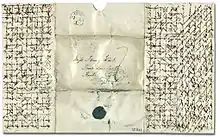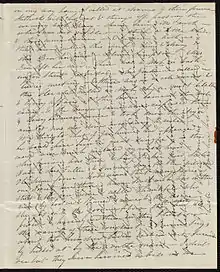Crossed letter
A crossed letter is a manuscript letter which contains two separate sets of writing, one written over the other at right-angles.[1][2] This was done during the early days of the postal system in the 19th century to save on expensive postage charges, as well as to save paper. This technique is also called cross-hatching[3] or cross-writing.[4][5]

A crossed letter, 1837, Ontario, Canada

Cross-hatched letter of 1837, Massachusetts, USA.
A cross letter is distinct from a palimpsest, as cross-hatched manuscripts were written this way at one sitting or for the same purpose (such as a diary), rather than being re-used later.
References
- "A crossed letter". Archived from the original on 2011-08-14. Retrieved 2011-03-27.
- Livingston, Ira (1997). "The Romantic Double-Cross: Keats's Letters". Arrow of Chaos: Romanticism and Postmodernity. University of Minnesota Press. p. 143. ISBN 0-8166-2795-9.
- Hassam, Andrew (1994), Sailing to Australia: shipboard diaries by nineteenth-century British emigrants, Manchester University Press ND, p. 27, ISBN 0-7190-4546-0
- "Cross-Writing: When People Wrote Across the Page to Save Paper". Blog.paperblanks.com. 2013-03-14. Retrieved 2018-06-26.
- "Cross Writing - What Is It and How Do You Read It? | Lonetester HQ". Lonetester.com. Retrieved 2018-06-26.
This article is issued from Wikipedia. The text is licensed under Creative Commons - Attribution - Sharealike. Additional terms may apply for the media files.
